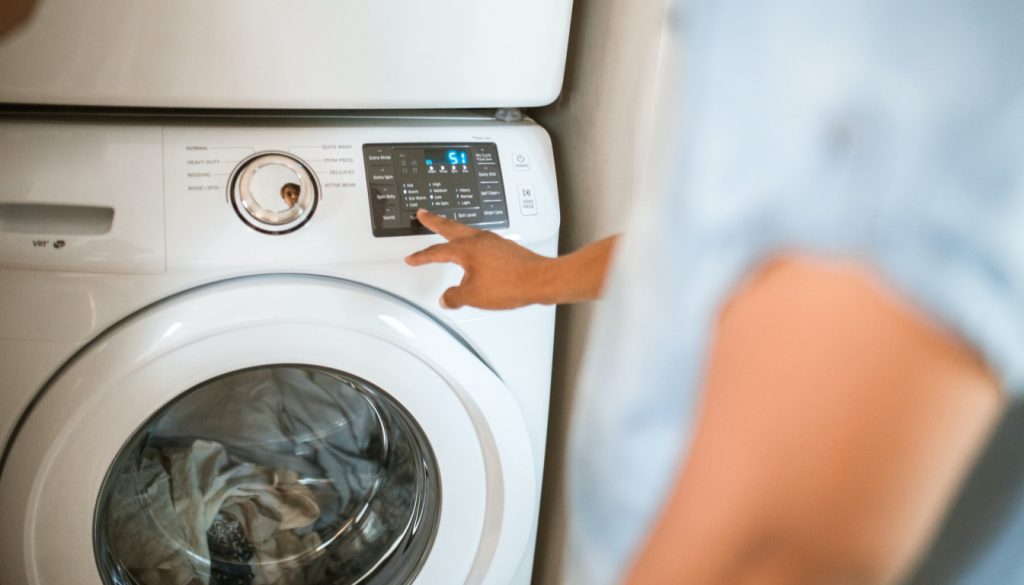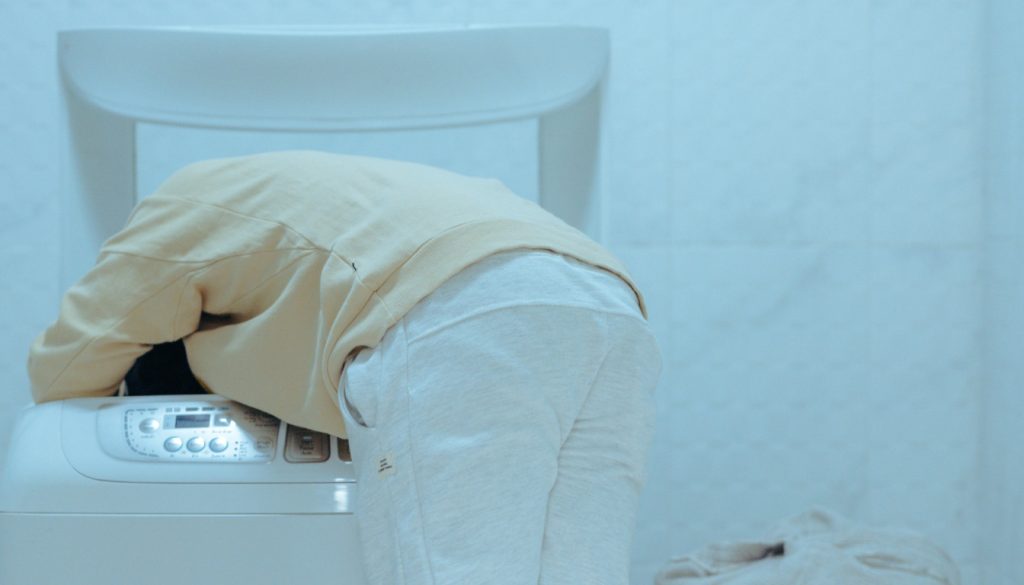
Does your laundry still smell a bit funky, even after a wash? You might not realize it, but your washing machine can harbor bacteria and mold. In this guide, we’ll show you how to disinfect your washer step by step so clothes come out truly clean and fresh.
Don’t worry; it’s easier than you think!
Key Takeaways
- Disinfecting your washing machine regularly is crucial for maintaining cleanliness, preventing mold and bacteria growth, and ensuring optimal appliance longevity.
- Use bleach diluted in water to disinfect a top-loading or front-loading washing machine, or use natural alternatives such as vinegar and baking soda to achieve the same results without harsh chemicals.
- Regular cleaning not only removes bacteria and mold but also leads to cleaner clothes with each wash while extending your appliance’s lifespan.
- Choosing suitable equipment/tools including rubber gloves, cleaning brush, disinfectant/sanitizing wipes, all-purpose cleaner towels/scrubbing pad/detergent will ensure effective regular cleaning maintenance that prevents mold growth and ensures your washing machine maintains optimal performance.
Why Regular Cleaning Is Important

Regular cleaning is important for sanitization and disinfection benefits, prolonging the lifespan of appliances, preventing mold and bacteria growth, and removing build-up of dirt and detergent.
Sanitization and disinfection benefits
Keeping your washing machine in top-notch condition isn’t just about making it last longer; it’s a serious matter of household cleanliness. Sanitization and disinfection go hand in hand to ensure that common bacteria don’t stand a chance, especially where you clean your clothes.
High temperatures and specific sanitize cycles are designed to tackle these microscopic invaders, ensuring your laundry comes out not just looking clean but actually being sterile.
Clean machines lead to cleaner clothes. Debris, dirt, and leftover detergent can turn the inside of your washer into a playground for germs—ones that hitch a ride on your t-shirts and jeans right back into the world.
By regularly removing these unwanted guests with proper cleaning agents or even simple items like bleach or vinegar, you control contamination effectively, giving peace of mind every time fresh laundry is folded.
Prolonged lifespan of appliances
Just as sanitizing your washing machine keeps it hygienic, regular maintenance ensures that every load spins smoothly for years. Cleaning isn’t only about freshness; it also promotes equipment longevity, an essential factor in home appliance upkeep.
Descale your washer every nine months to combat hard water minerals that could lead to clogs and hinder appliance performance. This preventative maintenance not only enhances durability but also secures efficient operation, allowing you to delay expensive replacements.
Keeping on top of your cleaning regimen prevents the accumulation of grime and detergent leftovers that can strain your machine’s components. By sticking to a consistent maintenance schedule, you safeguard the intricate parts of your washer against premature wear.
As a result, routine care lays the foundation for household appliances to surpass their expected lifespans while delivering optimal results with each use.
Preventing mold and bacteria growth
Let mold and bacteria know they’re not welcome in your washing machine by cracking the door open after each cycle. This simple act airs out the machine, helping to keep it dry and less hospitable to unwanted microbial guests.
Also, tackle soap scum and debris head-on with regular scrubs; these unwelcome particles are like a buffet for germs, setting the stage for them to grow and multiply.
To maintain tip-top washing machine hygiene, make cleaning more than an occasional chore. Set a schedule that keeps mold and bacteria at bay before they settle in. Consider this part of your routine appliance maintenance, safeguarding both your health and your washer’s performance.
Now that you know how to prevent these unwelcome invaders from taking over, let’s gear up with what you’ll need for the cleaning mission ahead.
Removing build-up of dirt and detergent
To prevent mold and bacteria growth, it’s essential to regularly remove the build-up of dirt and detergent from your washing machine. By doing so, you can ensure that residue accumulation is minimized, allowing for a clean and efficient appliance.
Regular cleaning – about once a month or every 30 wash cycles – helps maintain the cleanliness of your washing machine, preventing soil and grime build-up while extending its lifespan.
White vinegar is an effective alternative to detergents for regular cleaning, helping to remove build-up and reduce residue.
Materials You’ll Need
Equipment/tools: a cleaning cloth, scrub brush, and gloves. Cleaning solutions: bleach or vinegar and baking soda. Want to know how to disinfect your washing machine? Keep reading for step-by-step instructions!
Equipment/tools
Protective gloves are necessary to protect your hands from harsh cleaning chemicals and grime when disinfecting a washing machine. A cleaning brush is essential for scrubbing away stubborn dirt, grime, and mold in hard-to-reach areas of the washing machine.
For thorough sanitation, ensure you have disinfectant or sanitizing wipes to clean and kill germs on all surfaces of the machine. In addition, using an all-purpose cleaner can help remove any remaining residue and leave the machine smelling fresh.
Towels are useful for drying off the interior after cleaning, while a scrubbing pad can aid in tackling tough stains and build-up inside the drum. Lastly, having a reliable detergent on hand is crucial for regular maintenance washes to keep your washing machine clean and odor-free.
Cleaning solutions
To complement your equipment and tools, there are various cleaning solutions you can use to disinfect your washing machine. Apart from the commonly known chlorine bleach, alternative cleaning solutions such as pine oil, phenolic disinfectants, or quaternary disinfectants can effectively sanitize and remove bacteria from your machine.
These options provide a range of choices for individuals who prefer alternatives to traditional bleach-based cleaners. Additionally, laundry sanitizing products or using a sanitary cycle on your washing machine can also contribute to keeping it clean and free from harmful bacteria.
In conjunction with maintaining regular upkeep of your washing machine, utilizing these different cleaning agents ensures that you have multiple options for keeping the interior of your appliance sanitary and disinfected.
How to Disinfect a Washing Machine With Bleach
The use of bleach in cleaning your washing machine can effectively kill bacteria and remove stubborn mold and mildew. Learn the step-by-step process to disinfecting your washer with bleach and keep it clean and sanitized.
Read on for more tips on how to maintain a germ-free laundry machine.
Using bleach
To disinfect a washing machine with bleach, dilute 1/2 cup of bleach in the standard detergent dispenser or mix it into a quart of water before adding it directly to the wash drum.
Run an extra rinse cycle after the main wash to ensure all traces of bleach are rinsed away, and leave the door open to air dry. Opting for laundry bleach instead of regular cleaning bleach is crucial to prevent damaging clothes’ fibers.
It’s important to manually select an extra rinse if necessary and repeat the steps as needed when deep cleaning.
How to Disinfect a Washing Machine Without Bleach
To disinfect a washing machine without bleach, you can use vinegar and baking soda. These natural cleaning agents are effective in removing germs and odors from the machine. Alternatively, there are also other alternative methods such as using hydrogen peroxide or citric acid for disinfection.
Using vinegar and baking soda
Vinegar and baking soda are effective natural cleansers for disinfecting a washing machine. They work well in combating odors and removing residue. Here’s how to use them:
- Mix equal parts of white vinegar and water in a spray bottle.
- Spray the inside of the washing machine, including the drum and door seal.
- Wipe down all surfaces with a clean cloth or sponge.
- In a separate bowl, create a paste using baking soda and water.
- Apply the paste to any stubborn stains or areas with built – up grime inside the machine.
- Let it sit for 15 – 30 minutes before scrubbing with a brush or sponge.
- Run a hot water cycle without any clothes in the machine to rinse out the mixture.
Alternative methods
Pine oil, phenolic disinfectants, and quaternary disinfectants serve as nontoxic alternatives to chlorine bleach for cleaning a washing machine. These natural disinfectants are effective in removing mold, mildew, and everyday grime without harsh chemicals.
Similarly, using white vinegar and baking soda as an eco-friendly option can effectively sanitize the washing machine’s interior, providing a sustainable and non-toxic approach to maintaining cleanliness.
For those seeking chemical-free cleaning options, homemade solutions like pine oil or other organic cleaning alternatives prove to be environmentally safe choices. By utilizing these green cleaning methods, individuals can achieve sanitization while contributing positively to the environment through the use of sustainable cleaning products.
How to Clean a Top-Loading Washing Machine

First, start by running a hot water cycle with bleach to disinfect the interior of the machine. Then, wipe down the agitator and drum with a cleaning solution and scrub any stubborn stains with a brush.
Finally, clean the dispensers and lid with a mixture of water and detergent to ensure all areas are thoroughly sanitized.
Step-by-step instructions for a Top-Loading Washing Machine
To clean a top-loading washing machine, follow these steps:
- Mix 1/4 cup of bleach with 1 quart of water.
- Pour the bleach solution into the empty tub and run a complete cycle on hot water.
- After the cycle is complete, wipe down the interior with a damp cloth and leave the lid open to air dry.
- To deep clean, remove the agitator cap and wash it in warm, soapy water.
- Wipe down the exterior with a damp cloth and a vinegar or diluted bleach solution to sanitize.
Recommended products: Top Loading
For top-loading washing machines, an effective all-purpose cleaner is a must-have product to keep the interior fresh and clean. Look for a cleaner that is suitable for use in washing machines and can easily remove dirt, grime, and detergent buildup.
Additionally, having white vinegar on hand is essential for natural cleaning solutions. It’s an eco-friendly option that can help eliminate odor-causing bacteria and mineral deposits from the machine.
To maintain your top-loading washer, it’s important to choose products that align with the manufacturer’s recommendations. Using an all-purpose cleaner combined with occasional vinegar treatments will help keep your machine running smoothly while maintaining its cleanliness and freshness without causing damage or wear.
How to Clean a Front-Loading Washing Machine

For a front-loading washing machine, start by wiping down the rubber seal and door with a mixture of vinegar and water to remove any mold or mildew. Then, run a hot cycle with baking soda, followed by another hot cycle with distilled white vinegar to disinfect the drum and remove any lingering odors.
Be sure to also clean the detergent dispenser and filter to ensure your machine stays in top condition.
Step-by-step instructions for a Front-Loading Washing Machine
To clean a front-loading washing machine, follow these steps:
- Clean the rubber seal and door glass with a mixture of liquid bleach and water to remove any mold or mildew buildup. Use a small brush to scrub the crevices thoroughly.
- Use washing machine cleaner or affresh tablets to clean the washer drum. Follow the manufacturer’s instructions for the appropriate use of these cleaning products.
- Wipe down the exterior of the machine using cleaning wipes and a mild detergent solution to eliminate dirt and grime. Pay attention to control panels, knobs, and handles.
- Run a cleaning cycle with liquid chlorine bleach or distilled white vinegar to sanitize the interior of the washer. Ensure there are no clothes inside before starting this process.
Recommended products: Front Loading
After cleaning your front-loading washing machine, it’s essential to use the right products to maintain its cleanliness. To prevent mold and mildew, consider using specialized washer cleaner tablets designed for front-loading machines on a monthly basis.
Wiping down the door gasket regularly and running the Clean Washer cycle can also help in preventing odor and mold growth. Additionally, using liquid chlorine bleach or distilled white vinegar is effective in disinfecting and eliminating any lingering odors from your front load washer.
When it comes to maintaining a clean and odor-free front load washer, there are several key products that can make a significant difference. Incorporating these recommended products into your routine maintenance schedule will help keep your washing machine smelling fresh while ensuring optimal performance and longevity.
Cleaning The Exterior of The Machine and Dryer
To clean the exterior of the machine, use a mixture of warm water and mild detergent to wipe down the surface. For the dryer, use a damp cloth to remove any lint or debris from the exterior and sanitize with a disinfectant spray.
Cleaning the exterior of the machine
To clean the exterior of the machine, mix equal parts white vinegar and warm water to create a homemade cleaning solution. Use a microfiber cloth to wipe down the outside of the washer and dryer with the vinegar and water mixture. Scrub any stubborn stains or dirt as needed using the cloth. If preferred, a mild dish detergent mixed with water can also be used to wipe down the exterior surfaces of the washing machine and dryer. Make sure to rinse thoroughly with clean water after using any cleaning solution.
How to sanitize a dryer
- To ensure proper sanitation of the dryer, start by turning off and unplugging the appliance to prevent any accidents.
- Begin by cleaning the lint trap thoroughly to remove any trapped lint and debris that could pose a fire hazard.
- Wipe down the interior of the dryer drum using a damp cloth and mild soap to remove any stains or stuck-on items that could harbor bacteria or mold.
- Check for clogs in the vent and clear them using a vent brush or vacuum to ensure proper airflow and prevent potential fire hazards.
- Vacuum debris from the lint using a vacuum attachment to remove any lingering particles that could affect the efficiency of the dryer.
Routine Maintenance and Tips
– Clean your washing machine at least once a month to prevent mold and bacteria growth.
– Use less detergent to avoid build-up in the machine and reduce the need for frequent cleaning.
– Wipe down the exterior of the machine regularly to keep it looking clean and sanitary.
How often to clean your washing machine
Experts recommend cleaning your washing machine about once a month or every 30 cycles to prevent buildup and soils. It is ideal to maintain the proper functioning of your machine by cleaning it monthly.
For those in areas with hard water, more frequent cleaning, approximately every 1-3 months, is recommended. If you are a heavy user, consider cleaning your washing machine once a month to ensure its longevity; however, lighter users can suffice with maintenance a couple of times a year.
Deep cleaning should be completed once a month to remove contaminants like mold spores and bacteria while also eliminating residue and mold buildup. Regardless of the type of washing machine you have, running an empty hot water cycle with one cup of oxygen bleach once every three months helps keep it clean.
Tips for maintaining a clean machine
To maintain a clean washing machine, follow these tips:
- Clean the detergent dispenser regularly to prevent buildup of residue and mold.
- Leave the door or lid open after each use to allow air circulation and prevent odor and mold growth inside the machine.
- Wipe down the rubber seal around the door to remove any trapped dirt, lint, or moisture.
- Run a hot water cycle with white vinegar once a month to dissolve mineral deposits and disinfect the interior of the machine.
- Use a washing machine cleaner product every few months to remove residue and odors from hidden parts of the washer.
Professional repair services for washing machines
To maintain a well-functioning washing machine, it is important to consider professional repair services. By addressing minor issues promptly, appliance repair services can help prevent breakdowns and costly water damage, ultimately extending the lifespan of your washer and saving you money in the long run.
Professional maintenance not only ensures that your washing machine remains in good working condition but also helps prevent potential issues such as water damage.
Preventative maintenance can go a long way in keeping your washing machine running efficiently. Timely repairs can help extend the appliance’s life and minimize the risk of expensive breakdowns and water damage.
Conclusion
To maintain a clean and hygienic washing machine, regular cleaning and disinfection are essential. Incorporate the outlined step-by-step guide using bleach, vinegar, or alternative methods for effective sanitization.
Keep your washing machine in top condition by following the routine maintenance tips and recommended products to ensure long-lasting performance. Regular cleaning not only removes bacteria and mold but also extends the lifespan of your appliance, providing you with cleaner and fresher laundry every time.
FAQs
1. How often should I disinfect my washing machine?
It is recommended to disinfect your washing machine every 2-3 months to prevent buildup of bacteria and mold.
2. Can I use regular household cleaning products to disinfect my washing machine?
Yes, you can use common household items such as white vinegar, baking soda, or bleach along with hot water for effective disinfection.
3. What are the signs that indicate a need to disinfect my washing machine?
Signs that your washing machine needs disinfection include unpleasant odors inside the drum, visible mold or mildew, or clothes not smelling fresh after a wash cycle.
4. How long does it take to disinfect a washing machine?
The time required to disinfect a washing machine varies based on the method used but typically takes around 1-2 hours for a thorough cleaning cycle.
5. Is it necessary to run an empty load after disinfecting the washing machine?
Yes, running one empty wash cycle with hot water and detergent following the disinfection process helps remove any residual cleaning solution and ensures thoroughly cleaned internal components of the washer.